The Apple iPad Pro Review
by Ryan Smith, Joshua Ho & Brandon Chester on January 22, 2016 8:10 AM ESTApple Pencil
At this point it probably goes without saying that Apple Pencil has been one of the major points of focus for this tablet. With the iPad Air 2, I noted that a proper stylus and keyboard would go a long way towards making the iPad more productivity focused. It turns out that Apple’s solution to the stylus part of the equation is a custom design that they call the Apple Pencil.
As best as I can tell, this stylus is at least somewhat capacitive-based. If Apple’s marketing material is accurate, it mentions a change from the 120 Hz sampling rate of the capacitive touch screen in normal use to 240 Hz when the stylus is detected. In addition to simple touch, the stylus measures pressure, azimuth, and altitude. When discussing azimuth, we’re basically looking at the angle that the stylus makes with the plane of the display, while altitude is the angle that the stylus makes relative to the normal of the display.
Charging the stylus is pretty simple. Included in the box is a female to female Lightning connector, so you can use a Lightning to USB cable to charge the stylus with either an AC adapter or a powered USB port. Of course, there’s also the case where you’re trying to charge the device on the go, in which case the stylus can be charged directly from either the iPad Pro or an iPhone. A lot of people have pointed out that this is a rather inelegant method of dealing with charging on the go, but given that the primary method of charging is through a Lightning connector I don’t really see any other solution to this problem, especially without compromising the ergonomics that come with the current design. Charging the stylus happens quickly enough that I never felt that it was a limiting factor in usage.
Apple Pencil itself is a comfortable instrument to write with. Unlike most styluses on the market designed to fit in a tablet or smartphone the body has a sufficiently large diameter that gripping it isn’t difficult for extended periods of time. The pencil also has an uneven weight distribution, which means that it won’t roll off of tables, though not so uneven that it's noticeable in the hand. The one problem worth noting here is that Apple Pencil is glossy plastic. After extended use I noticed that finger oil and lint had a tendency to produce an uncomfortable sensation. A matte soft touch texture may make more sense here, but that would introduce additional issues with the finish wearing off with extended use.
Credits to Nina Ling and Cory Ye respectively
Of course, the important part here is writing with the stylus. Although I’ve already discussed the application of note taking in class before, in the time since my initial remarks on the iPad Pro I decided to do an entire project report on Apple Pencil in order to get a better feel for the stylus and its usability. This was done for a digital logic project in which we were required to draw out finite state machine diagrams, truth tables, block diagrams, and other portions of the design. I would estimate that over the course of this project, I spent at least 4 hours a day using the iPad Pro for 2-3 days.
One of the most immediate observations I had was that in some ways, the iPad Pro with Apple Pencil is far and away superior to pencil and paper. Even using the rather spartan Notes app this became clear. There were multiple cases throughout this project where a change that would have been difficult to make with pencil and paper was relatively simple to do so with Apple Pencil and the iPad Pro. For example, in cases where extra precision was needed it was possible to zoom in to erase a portion of text precisely. When an erasure was done poorly or on accident, reverting it was trivial as well. The project report, which eventually spanned 16 pages in length was synced to iCloud and was accessible from laptops and smartphones, which meant that it would be difficult, if not impossible to lose accidentally. It’s also noticeably more convenient to carry around an iPad Pro rather than a folder filled with paper. Along the same train of thought, drawing long truth tables with the straightedge function of the Notes app is much easier than carrying around a ruler everywhere. It was also great to have the project requirements and the notes application open side by side, which meant that there wasn’t a need to print out the project spec.
One notable problem that I did encounter with the Notes app is when the work I was doing spanned more than one page/sketch. An example of this would be cases where I would have to construct a state table based upon a state diagram that was sketched based upon the project requirements. If the state diagram was on a separate page, then I would simply have to switch back and forth between the two sketches or save the relevant sketch as an image to view in the gallery application, which felt a bit clunky.
The other issue, as it turns out, was getting the sketches off of the iPad Pro onto my laptop once I was ready to turn my work in. On the plus side, because all of my sketches were already digitized there was no need to locate a scanner and generate images or PDFs. However, the Notes app felt noticeably constrained in terms of export options. For example, there was no way of turning the 16 sketches I had drawn into a PDF on the device. I also discovered that as of iOS 9.2 attempting to save all sketches as images was broken as only 5 of the 16 sketches were saved to the gallery. Exporting the sketches by attaching them to an email was also unacceptable as the email export resolution was nowhere near native resolution. In the end, in order to get all of the sketches I had made off of the iPad in full resolution I had to manually select each sketch and save it to the gallery, before uploading all of the images to Dropbox. From my laptop, I could then put all of the images together into a PDF or some other acceptable format for submission.
However, despite these issues I found that the iPad Pro was remarkable for doing what very few tablets have really succeeded at. The iPad Pro actually feels comparable to pencil and paper to the extent that I never once felt like I wanted to go back to pencil and paper while doing the final project. Both the display and the stylus have sufficient resolution to the extent that precise work is easily achieved. The feel of the stylus feels like a good pen or pencil, without odd weight distribution problems.
Latency is also exceptionally low compared to most consumer solutions. Out of curiosity, I borrowed a Wacom Cintiq connected to a Macbook Air with an Intel i5 4250U CPU (Haswell 1.3/2.6 GHz) to do a basic latency comparison. Using Adobe Photoshop on the Wacom Cintiq and Adobe Photoshop Sketch on the iPad Pro and a high speed camera, I attempted to characterize latency by using a simple pen tool (3 px, full flow) by measuring the delta in time from when the pen was at a specific point and when inking reached the same point.
| Stylus Latency - iPad Pro vs. Wacom Cintiq | ||||
| iPad Pro (Photoshop Sketch) |
Wacom Cintiq (Photoshop) |
|||
| Latency | 49ms +/- 4ms (3 frames) |
116ms +/- 4ms (7 frames) |
||
After a few trials I measured an approximate latency for the iPad Pro of roughly 49ms or 3 frames of delay, while the Wacom Cintiq in this configuration had roughly 116ms or ~7 frames of delay. It’s worth mentioning here that the camera I used was recording at 240 FPS, so these figures could be off by around 4ms even before accounting for human error. Although the Cintiq 22 HD does have higher latency, I wouldn’t put too much into this as it’s likely that a more powerful computer driving the display would narrow, if not eliminate the gap entirely.
For reference, I estimated the Surface Pro 3 to have about 87 ms or 5-6 frames of delay, and the Surface Book to have about 69 ms or around 4 frames of delay. However, in the case of the Surface devices I was using Fresh Paint, which is a drawing application that isn't exactly comparable to Photoshop but is sufficient for comparison purposes. To give an idea for how much the application has an effect on latency, the Apple Notes app has roughly 38 ms or around 2 frames of latency from when the stylus tip passes over one point to when the inking reaches the same point.
While not strictly hardware, the software equation is really a critical part here as there are actual applications for the Apple Pencil which make it possible to use right now. An example of this would be OneNote, uMake, and Adobe Comp CC/Photoshop Sketch. Some of these applications work shockingly well like Photoshop Sketch, while something like OneNote feels relatively sparse by comparison as pretty much the only thing you can do with the stylus is draw simple lines with pressure sensitive thickness, with some automatic conversion of drawings to basic geometric shapes. With the right software, I can easily see the iPad Pro completely displacing traditional note-taking in light of obvious advantages that would come with OCR and digitizing notes for easy search.


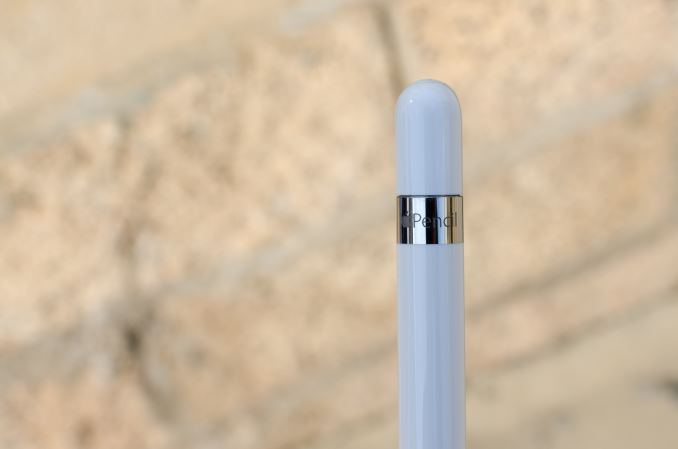
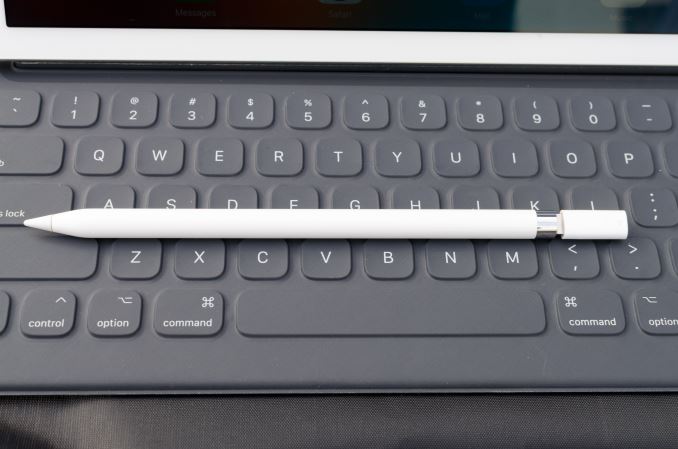
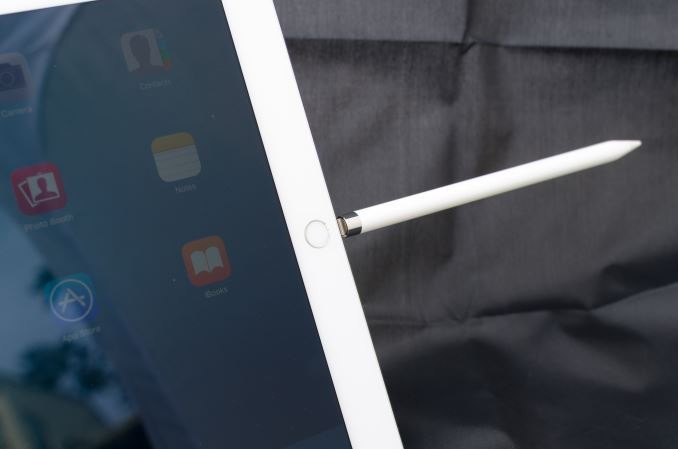

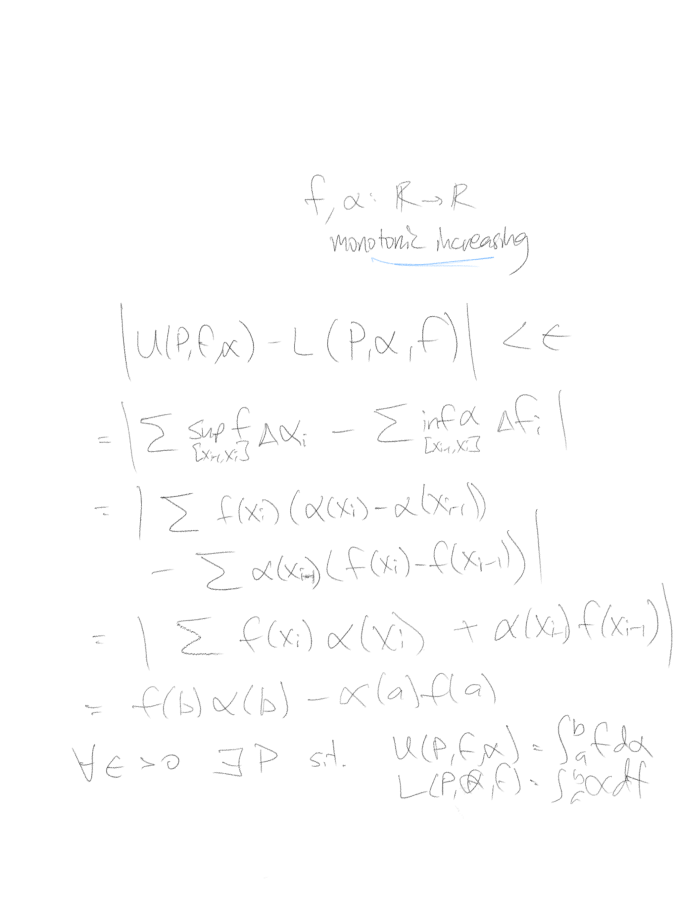
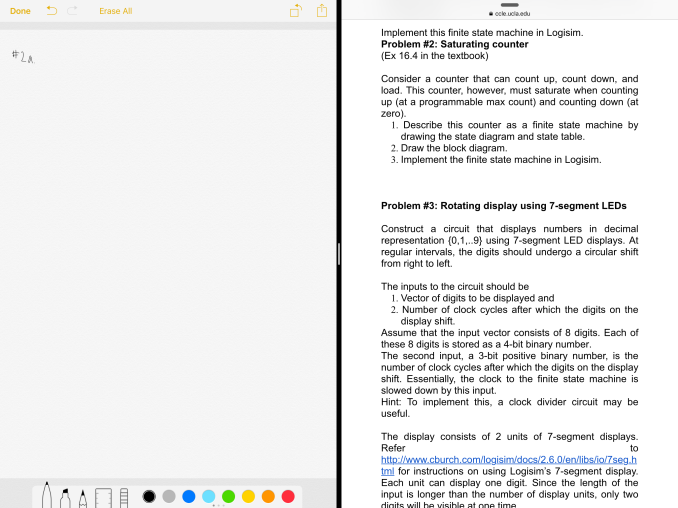
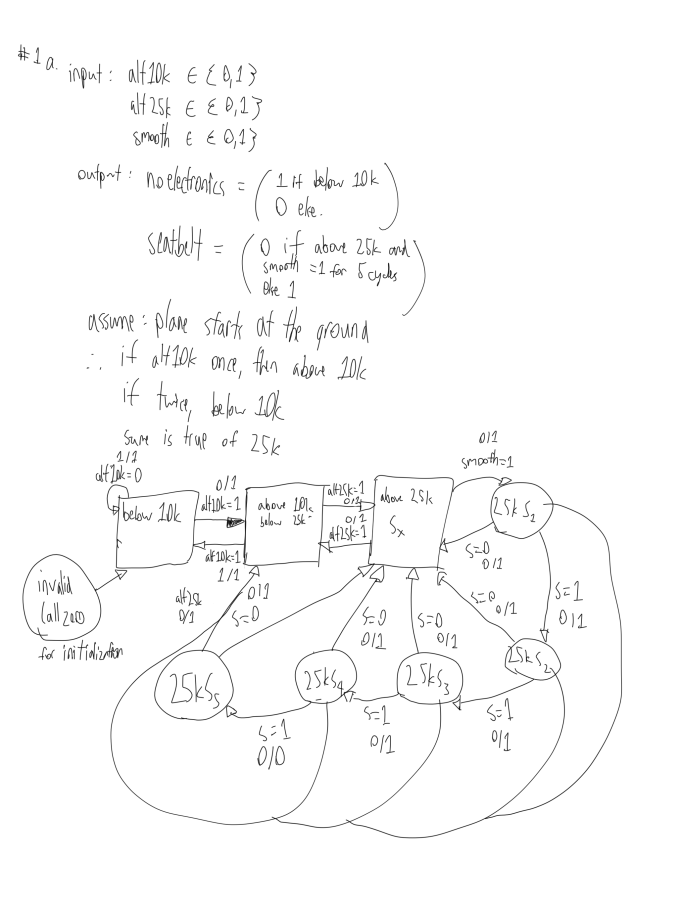
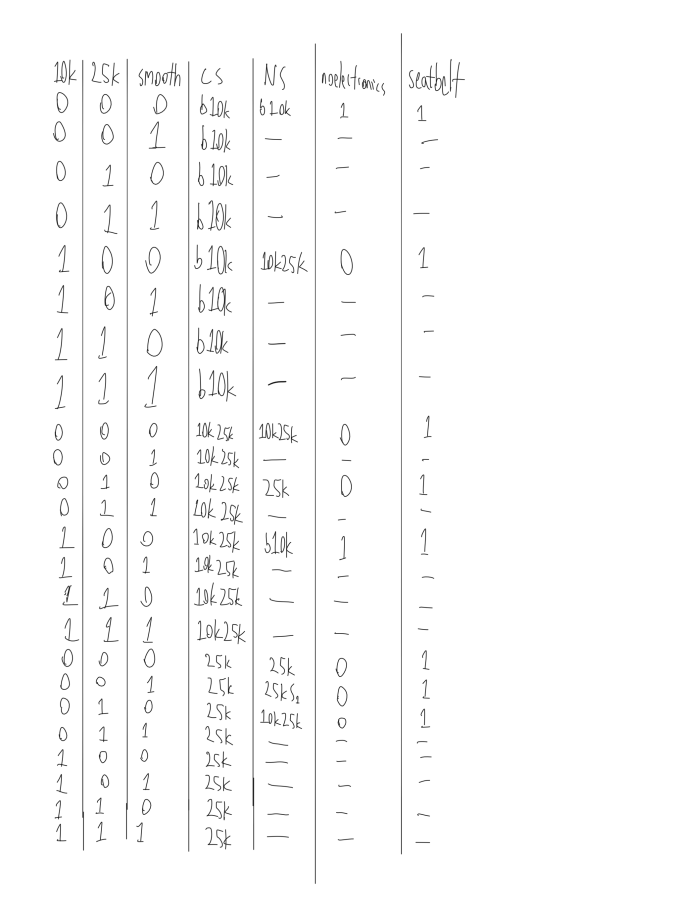

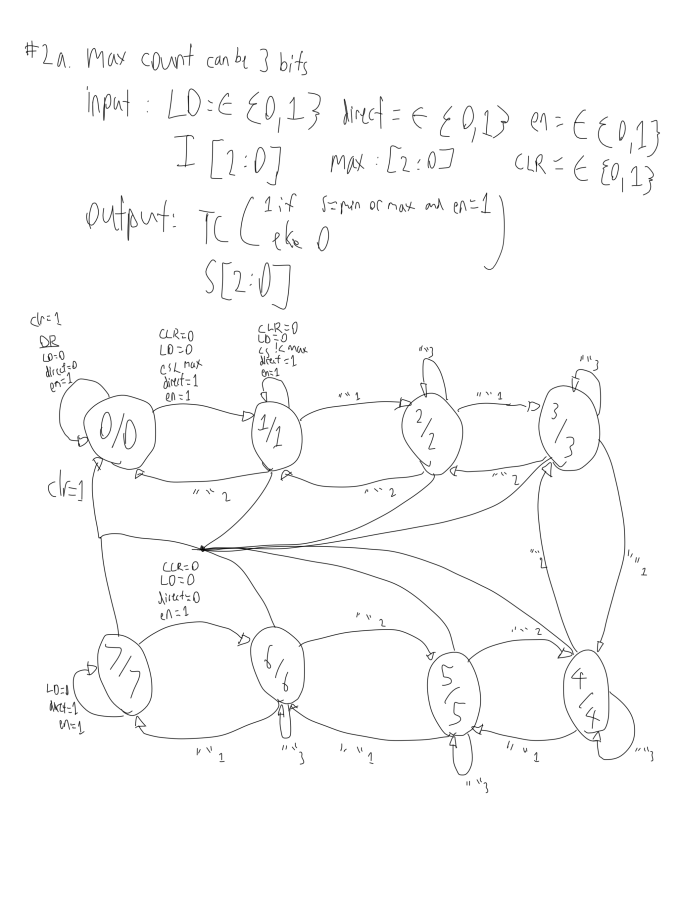
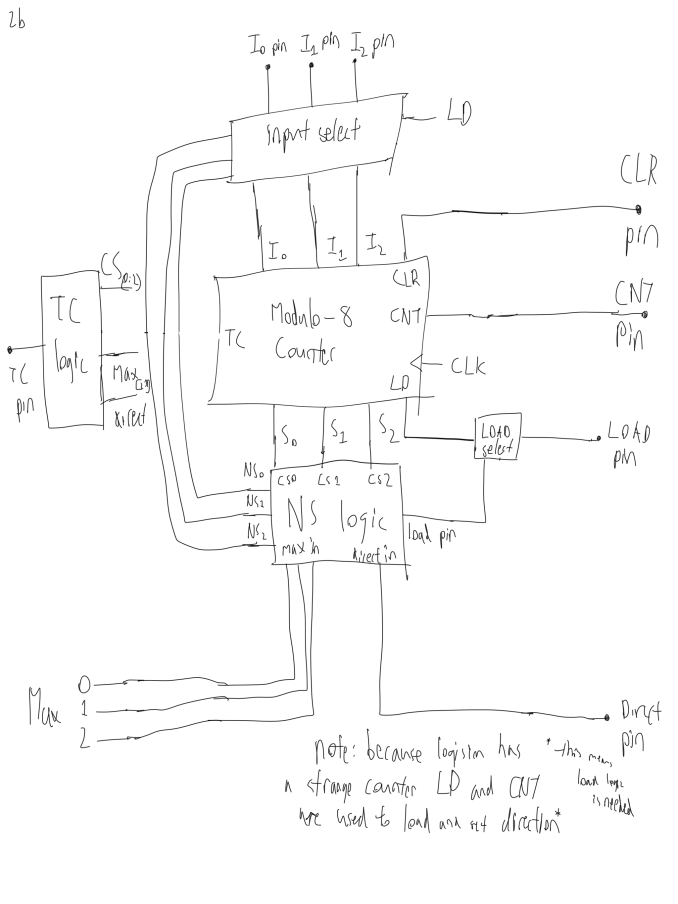
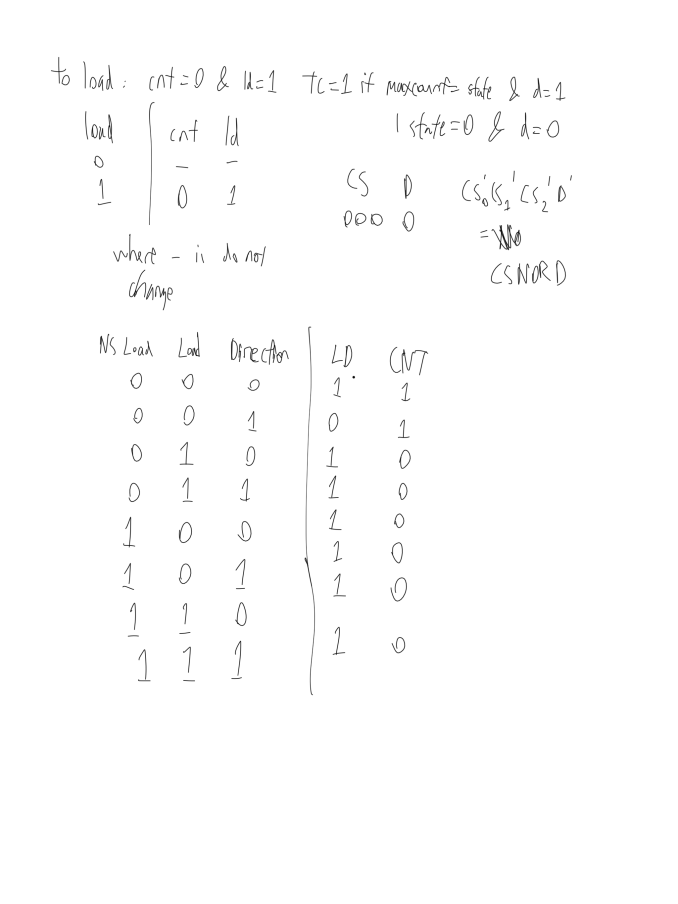
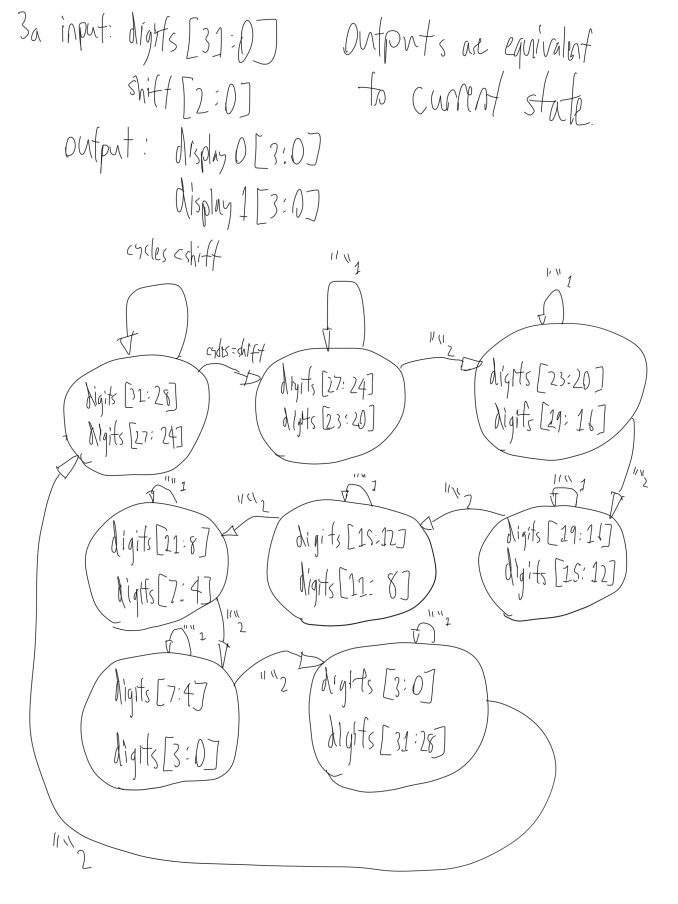

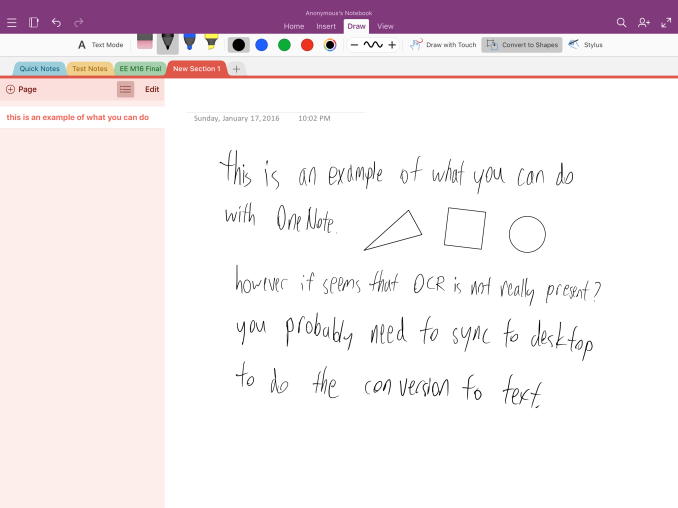








408 Comments
View All Comments
FunBunny2 - Saturday, January 23, 2016 - link
-- It's by now become a quasi-religious belief system for some that "mobile devices cannot ever be used for any professional purposes whatsoever!".despite what some think, Apple didn't invent the tablet. warehouses and manufacturers (when the US had them, of course) have used tablets with 802.11, and earlier protocols, for decades. all Apple did was create a consumer version.
Constructor - Saturday, January 23, 2016 - link
A "version" which "consumers" (apparently intended as a belittling epithet by you) can use, but the whole point is that it's not limited to that.akdj - Monday, January 25, 2016 - link
"You will still never be able to fit Photoshop's whole interface and abundance of options and menus into the tablet in a way that the user is easily able to reach them, without scrolling through pages of big buttons."Huh. Wonder why folks. The professional ones, for years have been buying Wacom tab companions to their 'workstation' specifically FOR PS, And EXACTLY for the reasons you outline, the ability to have precision touch and capacitance/tactile feel and response of real pencil or pen to paper. Some of these Wacom Photoshop controllers cost several times the price of the iPP for YEARS, & the iPP has its computer built in! No need to add a 'workstation'
You must've been hiding under a rock the last ½ decade. You've CERTAINLY not visited the App Store in some time. Adobe, Autoideskk Microsoft and the BIGGEST makers of "Content Creation" software are currently devoting MORE resources to mobile programming and development than their 'workstation' counterparts.
The 'big brow box' filled with diseases,; viruses - malware, adware, & the ilk's days are numbered. They're already on their way out of MANY folks' homes and offices being replaced by ultra books, passively cooled and ultra low voltage with ultra high efficiency is all the rage today. Battery life > 5 extra FPS, usability and funtionality > pure power, lotsa RAM, and expensive CPU and GPUs. Portability and the ability for 'instant on' access to their tab or phone > waiting til home, turning the power on, waiting for the boot. Opening PS (a slowly dying program with a phenomenal amount of alternatives on an iPad and iPhone and iDevice -- been that way for years, now with Adobe on board, their CreativeCloud suite offers a plethora of companion apps capable of ALL CS6's abilities as it's designed to aggregate and integrate with 'your' CC assets allowing for MOST editing ANYone will ever need on the iPad ...especially now with the display's ability to work with such an excellent active stylus and it's near direct comparison to Wacom's line of ...apparently unnessasary PS instruments and tools over the last decade or two those 'productive individuals' have made many millions of dollars in publishing? Now an AIO system with its OWN computer built in - a massive community of developers, independent to Adobe, friend next door or Autodesk themselves --- any software company interested in future survival in the industry is devoting more resources than ANY point in history to mobile dev. It's why MS, Adobe and AD were all there at the iPP unveiling. ALL demonstrating some phenomenal --- and yes, PROfessional use-case applications and software. I'm not a doctor but downloaded the examples shown at its unveiling of the Human Body atlas and AutoCAD --- its mind blowing how easily and flue to the iPad is able to manipulate such extensive detail and graphic overlays (nervous, muscular, skeletal, circulatory system overlays --- in any combination and with the ability to manipulate the direction you're looking at at a consistent 60fps) are MUCH better teaching aids - and learning that ANY static text book
Whether you ARE creating, flying a jet filled with passengers, entertaining a couple thousand folks at a concert, controlling inventory or filing your flight plan a personal pilot --- and probably 100,000 other occupations have been made significantly easier to accomplish, with less weight, more time away from the charger and 110v. That's what people need, want and are looking for. Unfortunately for Apple, they're making their iPad 'too well' --- as I've got the original, and an iPad 2 that both work, hold a charge and last as long as the Day I bought them six and five years ago respectively this year.
I also own the Air 2 and iPP and both have significantl impacts on my business I've run for nearly thirty years, successfully and exponentially dropping 'weight' every decade or so with something as capable as the always on, always connected and never a concern with battery life --- as the iPad is, easily replaces hundreds of dozens of crates of vinyl records! All while weighing about as much as a single - double record LP.
So, to summarize at the end of the day if you're a Photoshop user, you just got an incredible tool to augment your worlflow, make your photographic post production easier, organization and metadata handling, batch alteration or editing and aggregation of your library, metadata in tact and ready for post when you get home. No more off loading memory cards, organizing memory cards, redundantly dumping them for redundant/backup purposes and all the other BS that goes into using a dinosaur of a program FEW truly NEED for their projects.
Today, Adobe offers a ½ dozen "Photoshop" apps on iOS. Along with drawing, marking PDFs, even Premier and AE capture and integration (w/motion) - the options are becoming more extensive everyday, Adobe's just rewrote their entire app library and replaced each app for even better continuity for those still needing PS's tools or Acrobat's abilities beyond the $3, $5, $10 alternatives ...some, like Pixelmator, cross platform with ANY & EVERY PS tool the average layman could dream of --- available - @ the cost of a single month rental of PS/Lightroom 'rental'. And not just for hobbyists. Spend some time at DPreview.com to see the PS competition OR see Adobe's subscription tactics to maintain revenues.
It's not just a super powerful tablet. It's that and so much more thanks to an extensive and larger library of accessible software already matured to the point the App Store is - all in one place and all reasonably priced. Best prices and selection of software in history is currently more convenient and organized than ever and it's in the App Store
As devs have only had single GB of RAM, slower SoCs and smaller displays to program to over the last six years, even the Air 2 & 6s line of iPhones seems HUGE right now with double the RAM, graphics and compute. Double it again and you've got tether iPP. I'm already seeing apps available for Air 1/Mini 2 - 5s or A7/64bit iPads and newer to run the app.
As a daily user of the iPP for two months --- so many of your goofy statements make no sense, shout ignorance and beg to be straightened out --- but there's always a few schills around these parts beating an incredible product down while the masses of us are enjoying it!
Silly Murloc. What is it that makes YOU a Pro, and why is it YOUR job wouldn't be made easier or convenient with a tablet?
jlabelle - Thursday, January 28, 2016 - link
" now with Adobe on board, their CreativeCloud suite offers a plethora of companion apps capable of ALL CS6's abilities as it's designed to aggregate and integrate with 'your' CC assets allowing for MOST editing ANYone will ever need on the iPad"a very big big rant that just fall flat because of false premises. The claim above is a good example : simple case that most photographers need : Can I develop my RAW files on an iPad ?
When I mean developing, it is the normal basic reasons why you are shooting RAW in the 1st place : 1/ work in 16 bits mode so that you can push shadows / pull highlights and work on color without posterization ; 2/ apply automatically the lens correction (distorsion, CA, vignetting, ...) and 3/ have a color managed workflow (take into account the color space of the RAW file, have a calibrated display...)
The answer is ... drums rolling : you can NOT.
And you do not need a CS subscription to do that on a Surface, you can just purchase once Capture One Pro, DXO Optics... what you want. So what you can do with a Windows tablet, you simply cannot on an iPad Pro.
This is just one example but the same is true for a list so long that it makes no sense to try argue against that.
Gastec - Monday, January 25, 2016 - link
A gamer you would know what Pro moniker means.It goes like this: "I'm a Pro, gamer or whatever" meaning "I'm a big shot, a slick, better and cooler that you". And that's what iPad means when it says it's "Pro" :)
KPOM - Friday, January 22, 2016 - link
What do we need all the ports for? Most people, even in offices, can get by with wireless networks and printing these days.xerandin - Saturday, January 23, 2016 - link
Quadro*rabastens23 - Friday, January 22, 2016 - link
"Performance is better than a high end workstation from 10 years ago, a system which was capable of running professional tasks which are still nowhere to be found on mobile platforms."That's sort of an odd claim - what are those tasks, exactly? And if it's not a performance issue, why do you need an iPad Pro to do them?
ddriver - Friday, January 22, 2016 - link
Design, engineering, content creation. Basically every scenario that involves making something professionally rather than consuming something.Nobody needs a ipad pro to do this, point is the device is powerful enough for such tasks, and it would be nice if there was the software for it, in order to make that device truly PRO as in useful to professionals and not "pro" as in an empty marketing BS.
lilmoe - Friday, January 22, 2016 - link
DUDE. Software is NOT the only thing the iPad "Pro" is missing for it to be a Pro tablet. Get this through your head.The hardware is lacking even if it were much more powerful. The OS is also lacking.